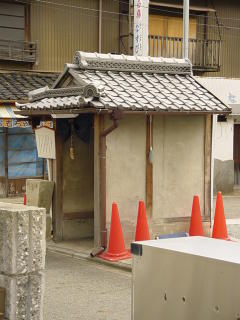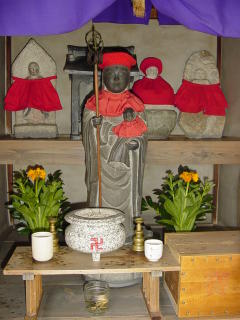"Jizou": Guardian Deity of Children
 Guess what's inside this little "house"? It's not an outhouse, although it's right about the same size.
Guess what's inside this little "house"? It's not an outhouse, although it's right about the same size.It houses several "gods" inside. Since I hardly know a thing about buddhism, I don't really know what the proper name is. They're called "Ojizou" in Japanese, which according to the online dictionary means "guardian deity of children."
Usually the stone buddhas with red aprons on them, are just placed out in the open or under small wooden shelters. The little Ojizous in this "shelter" got lucky I guess, because the neighborhood people built a nice little home for them.
People seem to take really good care of the Ojizous in this shelter. Someone always puts fresh flowers, leaves tea or sweets, and burns incense as an offering to the deity. The little sign in the front said that when there was a fire in the area, the house on the same property got burned to the ground, but the Ojizou's home remained unscathed. Kinda spooky.

 Personally, I always wonder what the red apron stands for. Why is it red? Why do they need aprons? I haven't looked into it yet, but if I find the answers, I'll let you know.
Personally, I always wonder what the red apron stands for. Why is it red? Why do they need aprons? I haven't looked into it yet, but if I find the answers, I'll let you know.Oh yeah, see the little swastika on the incense bowl? I was at first very shocked to find the insignia on these religious items. Why would they put something so shocking on things that are supposed to stand for peace, right? Well, I don't remember the full explanation, but in zen buddhism, the swastika or manji, as they call it, stands for the ideal harmony between love and intellect...and it existed much earlier than the Nazis. It's too bad that the original meaning didn't spread out into the world and it became more of a symbal for hate.

3 Comments:
Actually, they look similar but manji and swastika are not the same. The direction that the spikes turn is opposite which is an important difference. since the manji is supposed to represent "good" having the spikes turn opposite means "evil" which is fitting don't you think? The manji as you say existed way way before the Nazis.
SM
Thanks for the information SM! I didn't look into it THAT much, so I didn't realize the points were in different directions =). So you thought it was odd too?
yeah and about the red maekake of the ojizous, one theory is that they don't mean anything (funny)
SM
Post a Comment
Subscribe to Post Comments [Atom]
<< Home